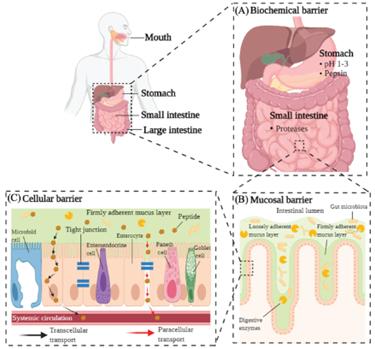News
Retatrutide oral or injectable
Retatrutide is a new weight loss drug by Eli Lilly, The retatrutide phase 2 trial obesity results show it achieve a mean weight reduction of up to 17.5% at 24 weeks and 24.4% at 48 weeks in obese/overweight adults.
Can Retatrutide be given orally? Obstacles faced by oral peptides
Let's first briefly understand the obstacles faced by oral peptides, which mainly include biochemical barriers, mucosal barriers, and cellular transport barriers. Digestive enzymes and pH changes are the main biochemical barriers in biochemical disorders. In fact, from the moment peptide drugs enter the oral cavity, they come into contact with various digestive enzymes. However, due to the short action time of salivary amylase, the drugs are basically not degraded in the oral cavity. But when peptides enter the stomach, they are affected by low pH values (pH=1-3) and various gastric proteases, and the duration of the effect mainly depends on factors such as drug type, amount of food in the stomach, viscosity of food, and protein content. When peptide drugs enter the small intestine through gastric emptying, they are also affected by various proteases in the small intestine, such as trypsin, chymotrypsin, elastase, carboxypeptidases A and B, etc. Therefore, if peptide drugs are to be delivered orally, the first step is to protect the peptide drugs from the influence of pH value and various proteases in the gastrointestinal tract.

Mucosal disorders refer to a highly complex layer of mucus covering the surface of the human gastrointestinal tract that significantly hinders the absorption of drugs. This mucus is secreted by goblet cells and mainly composed of mucin, responsible for lubricating ingested food, maintaining the hydration layer of epithelial cells, and preventing pathogens and foreign substances from entering epithelial cells. For peptide drugs, drug molecules can only be absorbed through epithelial cells by penetrating the mucous layer, and the penetration of drugs in the mucous layer is mainly determined by the particle size and charge carried by the drug. For example, the porosity of the mucus layer is between 25-200nm, and mucin has a negative charge, so drug particles with a positive charge in this range are more likely to penetrate the mucus layer. And drugs that successfully pass through the mucous layer will pass through epithelial cells in two ways: paracellular transport and intercellular transport. Due to the tight connections, adhesive connections, and cell desmosomes between epithelial cells, paracellular transport is only suitable for peptide molecules with relatively small molecular weights (≤ 20kDa), and studies have shown that negatively charged molecules are more likely to pass through paracellular transport. The main obstacle in intercellular transport is that peptide drug molecules may be treated as foreign molecules upon entering small intestinal epithelial cells, which can be hydrolyzed by intracellular proteases or re excreted from small intestinal cells, all of which can affect the bioavailability of drugs.
Unlike Oral Semaglutide tablets, Retatrutide only given by injection
Oral semaglutide tablets have overcome the long-standing technical barriers of oral peptide drugs. By using the small molecule absorption enhancer SNAC, the pH value of the local environment after dissolution of the drug in the stomach was increased, effectively increasing the solubility of semaglutide while avoiding the dissolution of the drug by peptidases in the stomach. The appearance of oral semaglutide broke the pattern that the original blood glucose control drugs can only be administered by subcutaneous injection, providing less invasive and convenient treatment options for the majority of diabetes patients to control blood glucose.
Unfortunately, currently retatrutide peptides have not overcome this challenge and can only be injected for use.
CATEGORIES
News
- Retatrutide dosage chart2024-04-09
- Retatrutide's Side Effects2024-03-05
- What is retatrutide?2024-01-27
- Can retatrutide be taken orally?2024-05-07
- Retatrutide oral or injectable2024-04-18
CONTACT US
Contact: Retatrutide online
Phone: +86 18073326374
E-mail: rose@goodpeptides.com
Add: Science and Technology Industrial Park, Yuelu District, Changsha City, Hunan Province
